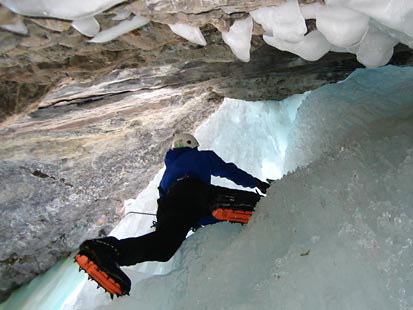Exclusive: Ice Climber Survives 72 Foot Fall
Climber saw faces of wife and son during long fall; said, "I'm sorry" for dying.
April 3, 2009 — -- When a nylon rope gave way and sent veteran climber Cri Boratenski hurtling 72 feet toward the earth as he climbed a Colorado ice sheet, the 31-year-old thought he wouldn't live to see his wife or 1-year-old son again.
It was an image of them sitting next to each other that flooded his mind during his freefall from the side of the Designator, a massive, vertical ice formation that hugs a cliff near East Vail, Colo. He thought about how he wanted to apologize to them for dying.
But, incredibly, the apology would be unnecessary because Boratenskisurvivedhis March 21 near-death experience.
"It's pretty amazing," Boratenski told "Good Morning America" in an exclusive interview, still wearing a neck brace. "I don't think anybody has a good explanation for why I'm here right now."
"It a pretty indescribable moment," Boratenski said of the instant he heard his anchors come loose in the ice. "When I heard that actual pop ... there was a moment of disbelief that I was actually falling and that there was nothing that was going to catch me."

The Evergreen, Colo., resident sustained injuries, which included a collapsed lung, broken nose, facial lacerations and nine broken vertebrae.
Yet Boratenski, who works as a mobile technology consultant, said he is amazed by his recovery. Within a week, he was back at work, albeit with back and neck braces, which he'll have to use for the next eight weeks.
Boratenski said he walks fine, though he can't do long distances and was surprised that he didn't receive more injuries.
From Fun to Frightening
Boratenski and two friends used a rig to climb up and down the Designator. Boratenski reached the top of the ice wonder first, and then the veteran climber made a crucial mistake, one that would send him on the near-fatal drop.

Using a technique called top-roping in which a rope runs from the bottom, through an anchor and back down to the climber, Boratenski opted to use the nylon rope as an anchor instead of a metal carabineer.

"As I was coming down, I felt one little pop, and then a second later, I felt the second pop," he said.
During his rapid decent, Boratenski, who began climbing at age 15, saw the ice formation to his right and his rope coiling in a bizarre way to his left while he was still close to the top.
"I was airborne," said Boratenski. "I looked over and saw the rope snaking around right next to me and falling at the same speed I was falling."
Falling Too High to Survive, Landing 'Not Soft'
Then it registered with him: He was falling. He was too high up to survive.
"I saw an image of my wife and an image of our son that was a year old," he said. "I said 'I'm sorry,' because I thought it was the last time I was going to see them."
Boratenski did not remember the impact but knows the ice-snow "wasn't soft."
It took rescuers 30 minutes to reach Cri, and another 2½ hours to get him down to the ambulance.
"It was kind of a very gradual process as I was coming to," Boratenski said. "I did have that moment where I thought I must not be alive right now. I must be looking at myself. I felt like I was looking at myself there on the ground for a very brief moment."
Boratenski attributed his accident to his "rookie" mistake, saying he used the wrong material.
"It wasn't the sport that failed me," he said. "It was my own dumb mistake."

As far as getting back up on the ice, Boratenski is noncommittal but said he doesn't have "any reservations about climbing again."
"It's a challenge knowing that if I do go back out there again, I'm putting [wife Julia] in a difficult place."